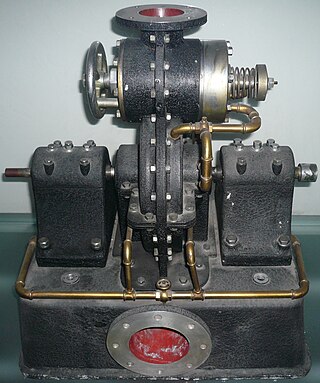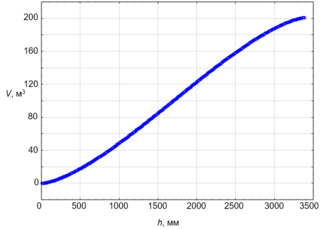Related Research Articles

A pump is a device that moves fluids, or sometimes slurries, by mechanical action, typically converted from electrical energy into hydraulic energy.

A turbine is a rotary mechanical device that extracts energy from a fluid flow and converts it into useful work. The work produced can be used for generating electrical power when combined with a generator. A turbine is a turbomachine with at least one moving part called a rotor assembly, which is a shaft or drum with blades attached. Moving fluid acts on the blades so that they move and impart rotational energy to the rotor. Early turbine examples are windmills and waterwheels.

The Tesla turbine is a bladeless centripetal flow turbine patented by Nikola Tesla in 1913.

A turbopump is a propellant pump with two main components: a rotodynamic pump and a driving gas turbine, usually both mounted on the same shaft, or sometimes geared together. They were initially developed in Germany in the early 1940s. The purpose of a turbopump is to produce a high-pressure fluid for feeding a combustion chamber or other use.

A water turbine is a rotary machine that converts kinetic energy and potential energy of water into mechanical work.

The turbojet is an airbreathing jet engine which is typically used in aircraft. It consists of a gas turbine with a propelling nozzle. The gas turbine has an air inlet which includes inlet guide vanes, a compressor, a combustion chamber, and a turbine. The compressed air from the compressor is heated by burning fuel in the combustion chamber and then allowed to expand through the turbine. The turbine exhaust is then expanded in the propelling nozzle where it is accelerated to high speed to provide thrust. Two engineers, Frank Whittle in the United Kingdom and Hans von Ohain in Germany, developed the concept independently into practical engines during the late 1930s.
Flow measurement is the quantification of bulk fluid movement. Flow can be measured using devices called flowmeters in various ways. The common types of flowmeters with industrial applications are listed below:

An air compressor is a machine that takes ambient air from the surroundings and discharges it at a higher pressure. It is an application of a gas compressor, and a pneumatic device that converts mechanical power into potential energy stored in compressed air, which has many uses. A common application is to compress air into a storage tank, for immediate or later use. When the delivery pressure reaches its set upper limit, the compressor is shut off, or the excess air is released through an overpressure valve. The compressed air is stored in the tank until it is needed. The pressure energy provided by the compressed air can be used for a variety of applications such as pneumatic tools as it is released. When tank pressure reaches its lower limit, the air compressor turns on again and re-pressurizes the tank. A compressor is different from a pump because it works on a gas, while pumps work on a liquid.

Centrifugal compressors, sometimes called impeller compressors or radial compressors, are a sub-class of dynamic axisymmetric work-absorbing turbomachinery.

Fluid power is the use of fluids under pressure to generate, control, and transmit power. Fluid power is conventionally subdivided into hydraulics and pneumatics. Although steam is also a fluid, steam power is usually classified separately from fluid power. Compressed-air and water-pressure systems were once used to transmit power from a central source to industrial users over extended geographic areas; fluid power systems today are usually within a single building or mobile machine.

A chiller is a machine that removes heat from a liquid coolant via a vapor-compression, adsorption refrigeration, or absorption refrigeration cycles. This liquid can then be circulated through a heat exchanger to cool equipment, or another process stream. As a necessary by-product, refrigeration creates waste heat that must be exhausted to ambience, or for greater efficiency, recovered for heating purposes. Vapor compression chillers may use any of a number of different types of compressors. Most common today are the hermetic scroll, semi-hermetic screw, or centrifugal compressors. The condensing side of the chiller can be either air or water cooled. Even when liquid cooled, the chiller is often cooled by an induced or forced draft cooling tower. Absorption and adsorption chillers require a heat source to function.

Hydraulic head or piezometric head is a specific measurement of liquid pressure above a vertical datum.
Condition monitoring is the process of monitoring a parameter of condition in machinery, in order to identify a significant change which is indicative of a developing fault. It is a major component of predictive maintenance. The use of condition monitoring allows maintenance to be scheduled, or other actions to be taken to prevent consequential damages and avoid its consequences. Condition monitoring has a unique benefit in that conditions that would shorten normal lifespan can be addressed before they develop into a major failure. Condition monitoring techniques are normally used on rotating equipment, auxiliary systems and other machinery like belt-driven equipment,, while periodic inspection using non-destructive testing (NDT) techniques and fit for service (FFS) evaluation are used for static plant equipment such as steam boilers, piping and heat exchangers.

An air flow bench is a device used for testing the internal aerodynamic qualities of an engine component and is related to the more familiar wind tunnel.
Specific speedNs, is used to characterize turbomachinery speed. Common commercial and industrial practices use dimensioned versions which are of equal utility. Specific speed is most commonly used in pump applications to define the suction specific speed —a quasi non-dimensional number that categorizes pump impellers as to their type and proportions. In Imperial units it is defined as the speed in revolutions per minute at which a geometrically similar impeller would operate if it were of such a size as to deliver one gallon per minute against one foot of hydraulic head. In metric units flow may be in l/s or m³/s and head in m, and care must be taken to state the units used.

Custody Transfer in the oil and gas industry refers to the transactions involving transporting physical substance from one operator to another. This includes the transferring of raw and refined petroleum between tanks and railway tank cars; onto ships, and other transactions. Custody transfer in fluid measurement is defined as a metering point (location) where the fluid is being measured for sale from one party to another. During custody transfer, accuracy is of great importance to both the company delivering the material and the eventual recipient, when transferring a material.
A rotodynamic pump is a kinetic machine in which energy is continuously imparted to the pumped fluid by means of a rotating impeller, propeller, or rotor, in contrast to a positive displacement pump in which a fluid is moved by trapping a fixed amount of fluid and forcing the trapped volume into the pump's discharge. Examples of rotodynamic pumps include adding kinetic energy to a fluid such as by using a centrifugal pump to increase fluid velocity or pressure.
A hydraulic compressor is a type of compressor that is designed to convert hydraulic power to pneumatic power. It is used across various industries to improve the efficiency of certain types of machinery. Hydraulic compressors have a hydraulic pump to push air through a pipe, which forces a motor to spin. The motor powers the internal air compressor, releasing air in a chamber as a result. Compressors became more popularized in 1799 when Englishman George Medhurst invented a motorized air compressor as a means for propulsion. They have technologically advanced to the point where they can achieve greater force and precision than humans.

Instrumentation is used to monitor and control the process plant in the oil, gas and petrochemical industries. Instrumentation ensures that the plant operates within defined parameters to produce materials of consistent quality and within the required specifications. It also ensures that the plant is operated safely and acts to correct out of tolerance operation and to automatically shut down the plant to prevent hazardous conditions from occurring. Instrumentation comprises sensor elements, signal transmitters, controllers, indicators and alarms, actuated valves, logic circuits and operator interfaces.
The Glossary of Geothermal Heating and Cooling provides definitions of many terms used within the Geothermal heat pump industry. The terms in this glossary may be used by industry professionals, for education materials, and by the general public.
References
- ↑ Advanced Thermodynamic Performance Measurements for pumps and pump systems, Malcolm Robertson, IMechE Seminar on Site Testing, London, June 2013.
- 1 2 BS ISO 5198:1999 Centrifugal, mixed flow and axial pumps - Code for Hydraulic performance tests - Precision Class.
- ↑ Thermodynamic performance testing and monitoring pumpindustry magazine, April 2013.
- 1 2 3 4 5 Toward Municipal Sector Conservation: A Pump Efficiency and Awareness Pilot Study Hydratek & Associates Inc, May 2013.
- ↑ ftp://140.98.193.80/uploads/pes/PowerAfrica2007/PowerAfrica-32-cattaeae.pdf.pdf
- 1 2 Pump Efficiency Testing By Thermodynamic Method.
- ↑ ATAP
- ↑ Wireless Thermodynamic Pump Monitoring
- ↑ Freeflow Portable Pump Testing System
- 1 2 P22 Pump Efficiency and Flow Meter
- ↑ Pump efficiency testing by the thermodynamic method - an independent view
- ↑ Flow Meter Piping Requirements
- 1 2 AEMS Testing and Monitoring Services
- ↑ Clifford, Tom. "Pump Centre Conference 2016 - Keynote Paper" (PDF).
- ↑ "Pioneering technology project scoops Pump Centre award 2016". www.riventa.com. Retrieved 2016-09-29.
- ↑ Thermodynamic method used for pump performance and efficiency testing program
- ↑ The reality of pump energy efficiency and performance: Canada sets example in characterizing actual energy efficiency of water pumps with province-wide testing program.
- ↑ Pump efficiency monitoring and management at Melbourne Water